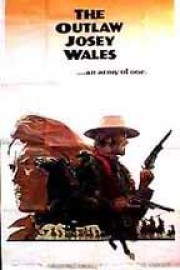The Outlaw Josey Wales
Josey Wales is a regular farmer who is plowing with his young son, when the film opens. His wife asks them to come in for dinner; the son goes, but Josey stays. Not long after, he sees smoke over where his house is. He runs to find his house on fire, and his wife and child under attack, and killed, but outlaws, who we will learn are in fact Union soldiers. After he buries them, he joins up with a Confederate group of men who go after Union soldiers for vengeance. After some of those men are killed by Union soldiers after pledging their loyalty to the forces, Josey Wales is on the run, not only from Northern soldiers, but the man who used to run Wales’s crew. and betrayed his own men.
All of this happens in the first 25 minutes of “The Outlaw Josey Wales,” a western from Clint Eastwood (who directed, and stars as Josey Wales) that finds an intriguing middle ground between the Sergio Leone westerns that made him famous, and his Oscar winning classic, “Unforgiven,” that brought an end to his time in the genre. Of course, the time that it was made falls right in the middle of those two periods, but more than that, the film’s story, and visual style is right in between the thematic and narrative elements of those films. By this point, Eastwood had already begun to establish himself as a director of the first-rate, but even though I’m still behind on his pre-“Unforgiven” directorial work, “Josey Wales” feels like a turning point, and maturing point, in his work as a filmmaker. His storytelling is confident and intelligent. He works from a strong screenplay (by Philip Kaufman and Sonia Chernus) that etches memorable characters with strong dialogue. And he gets fine performances all around as Josey finds something resembling a family by the time he and some companions make their way to a quiet town that was bustling once, but fell on hard times. Meanwhile, he still has to look over his shoulder as he still has people on his trail.
The film is based on a novel called, Gone to Texas, and those literary roots are evident throughout. There are archetypes of the genre that are obvious, to be sure, but our engagement in the characters (especially when Josey runs into Lone Waite, an old Indian played by the wonderful Chief Dan George in a wry, but dignified performance), and the way the characters are performed (by people like John Vernon, Sondra Locke, Will Sampson, and Sam Bottoms), is crucial to the film’s ability to hold our interest for 135 minutes. The “outlaw being chased” plot that begins the story moves in fits and spurts, as a lot of time is spent with the characters, and not a lot being chased. That’s not a bad thing, but it does rob the movie of some headlong momentum that could have been spent developing the two sorts of narratives concurrently, making it easier to building some tension. Nonetheless, “The Outlaw Josey Wales” is a fine, enjoyable piece of western filmmaking from Eastwood, who has never shied away from complicated emotional narratives, even if the story being told is anything but complicated.










